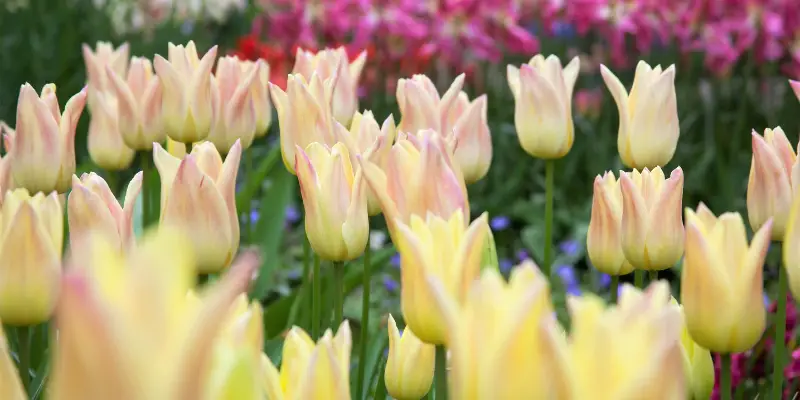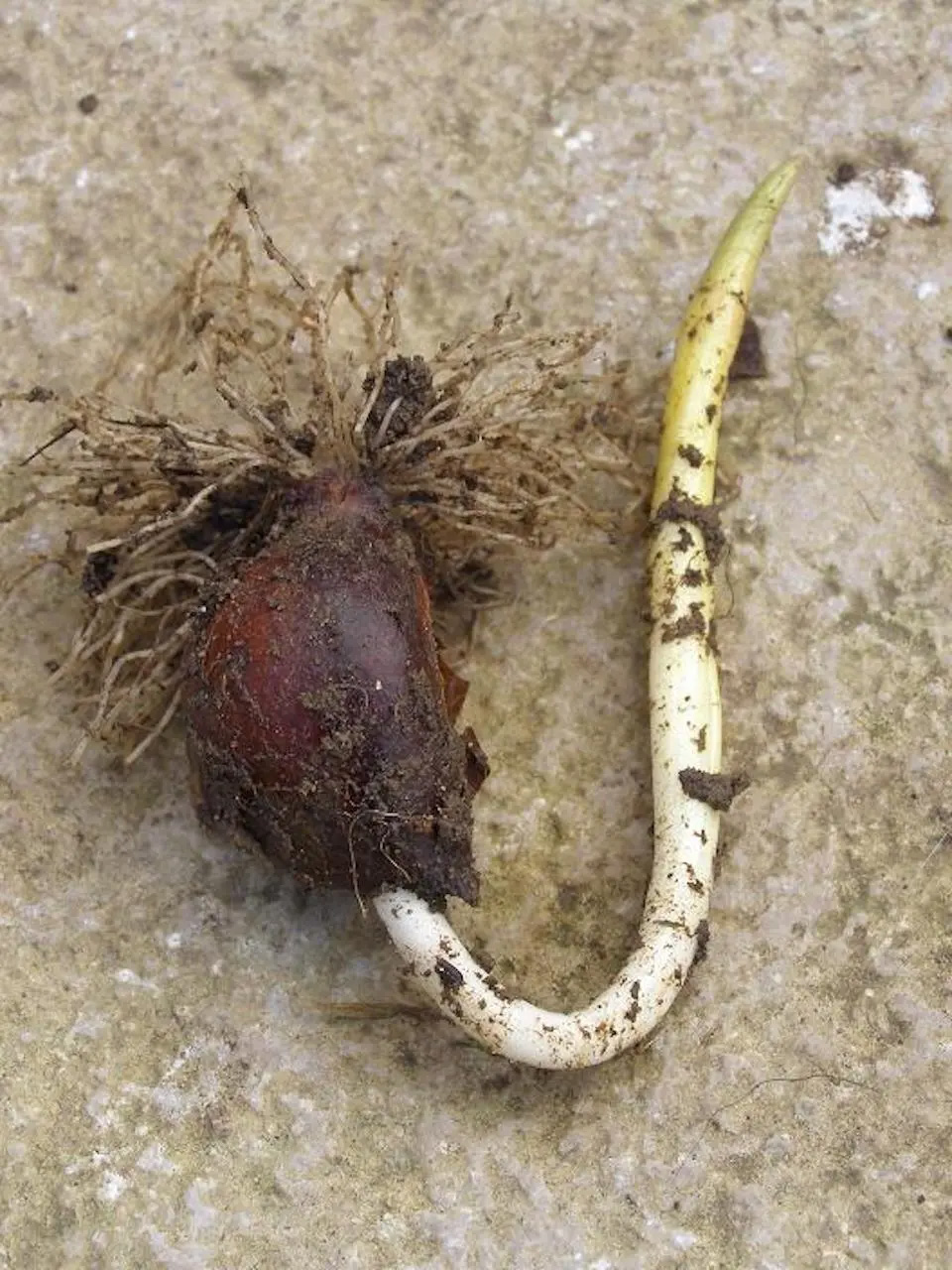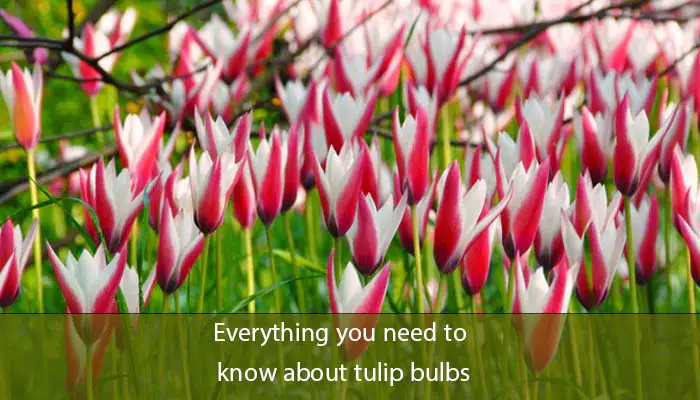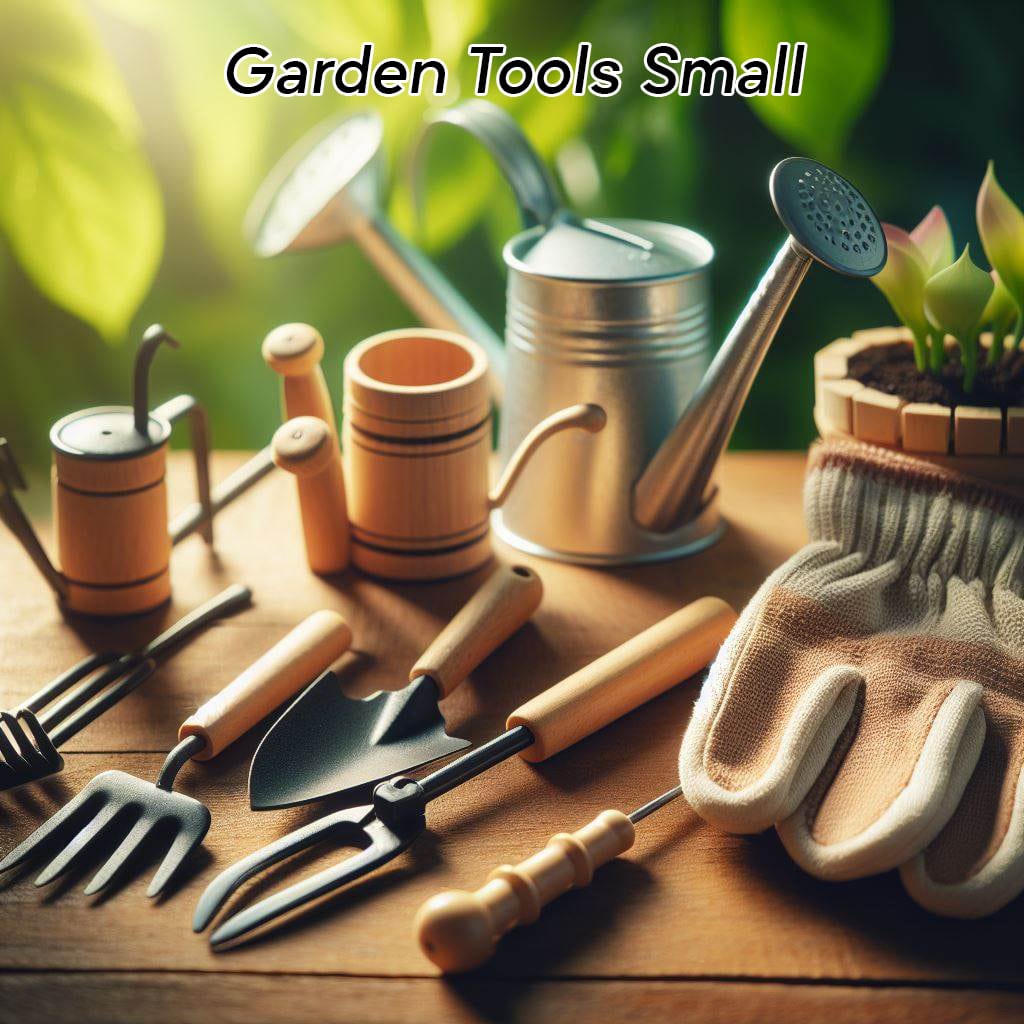How to Plant, Grow, and Care for tulip bulbs
Tulips are a popular and beautiful flower that adds a touch of spring to any garden, providing a beautiful variety of colors and shapes, making them a great value for both indoor and outdoor spaces.
Tulip bulbs are annual bloomers that typically bloom for one year after planting. They produce beautiful flowers in their first year, with a few green leaves in their second year, and possibly nothing in their third year. After flowering, they are harvested in flower bulb fields through deadheading, which provides nutrition to the bulb. After the remaining leaves turn yellow, the bulbs are lifted, cleaned, and stored dry before being returned to the ground in autumn. However, some tulips can be left in the ground and return the following year, known as perennial tulips. These tulips are planted once and remain in the ground after flowering, returning the following spring. Many of these tulips are botanical, resembling the original species. Perennial tulips can return annually if planted in nutrient-rich soil in a sunny, warm spot. You can also refer to the link to know “Can You Plant Bulbs In Winter?“
When should you plant tulip bulbs?
When to plant tulips Dry bulbs are planted in autumn (September to November) when the plant is dormant. If you’re not able to plant bulbs straight away, store them in a cool dry place. Plants bought in containers in spring from garden retailers are planted straight away and will bloom in a matter of weeks.
What is the best month to plant tulip bulbs?
September in cold climates (zones 3 to 5), October in transitional climates (zones 6 to 7), and November or December in warm climates (zones 8 to 9).
Can You Plant Bulbs In Winter?
Bulb-planting can continue even after the first frost or snow storm, as long as the ground is workable and a hole is deep enough to plant, allowing bulbs to be planted as late as January.
Fall is the ideal time to plant spring flower bulbs, such as tulips, narcissi, and hyacinths, as they bloom in spring. If you’ve missed this window, you can plant them in December or January, as long as the ground is not frozen hard and you can dig a spade into it. Plant bulbs at least 6″ deep for protection. If the ground is frozen hard, tulips and narcissi can be planted in pots. Store them in a cold, sheltered area over winter, such as an unheated garage or shed, and move them to your verandah, patio, or steps when the first shoots appear in spring. Grow bulbs like Amaryllis, Hyacinth, and Narcissus Paperwhite indoors, keeping them in a cool place until the first shoots appear, then move them to a warm, bright room. Plant a succession of bulbs to bring color and fragrance to your home all winter long. Choose your favorite varieties of hyacinths, daffodils, and tulips and get started!
What happens if you plant tulips late?

Bulb-planting can continue even after the first frost or snowstorm, as long as the ground is workable. Tulips and daffodils can be planted as late as January, allowing them to develop roots through spring and bloom later than usual. However, planting in late January may result in smaller blooms. Winter planting can also protect bulbs from hungry squirrels, as the ground freezes faster after planting, protecting them from the cold.
You can also visit this article for more information: What Happens If You Plant Tulips Late?
Can you leave tulip bulbs in the ground all year?
Tulip bulbs are often planted for their beautiful floral display but lack longevity in gardens. Some gardeners and landscape professionals plant them as annual crops, replacing them yearly or every other year to ensure maximum spring show. In the past, botanical and estate gardeners would dig bulbs in the spring to replace them with showy annuals, which were stored in a cool dark place for summer and replanted in the fall. However, most gardeners do not have ideal storage conditions or time to fuss. Northern gardeners can leave their bulbs in the ground year-round, while southern gardeners may need to purchase pre-cooled bulbs if their winter temperatures don’t provide the chill needed for blooming. Bulb planting time usually runs from November through mid-December in the south and West, and mid-December in south Florida and other warm regions.
What do you do with tulip bulbs after they bloom?
To encourage tulips to re-flower next year, remove seed heads after blooming, allow foliage to die back naturally, and dig up bulbs 6 weeks after blooming. Discard damaged or diseased bulbs and let them dry. Store them in dark, dry trays or nets over summer and replant them in the fall.

Question: What to do with tulip bulbs after they’ve bloomed in water?
How long does it take for a tulip to grow from bulb?
Generally tulips need 8 to 16 weeks of artificial winter. After bringing the plants into temperatures resembling spring, the tulip will sprout along with leaves quickly emerging. A flowering plant will then appear within 15 to 30 days.
How many years do tulips last?
Plant new tulip bulbs in the fall for better blooming. Modern tulip cultivars typically bloom for three to five years, but some types, like Darwin hybrid tulips and Fosteriana tulips, bloom for longer periods.
Daffodils are known as dependable perennials, returning year after year with more blooms. However, tulips are a unique type of flower that is easy to grow successfully in the garden. Although tulips are considered perennials, they don’t always behave as such. Technical director of the International Flower Bulb Center in Hillegom, the Netherlands, Frans Roozen, explains that tulips are true perennials. He states that they can bloom year after year in gardens located in the foothills of the Himalayas or the steppes of eastern Turkey. Roozen explains that the tulip thrives best in conditions that match the cold winters and hot, dry summers of its native regions. To thrive in Holland, one of the wettest countries on earth, a bit of know-how is required. Despite their beauty, tulips are not always able to perform well in the second or third year.
How do you keep tulips blooming every year?
- Choose the right variety.
- Provide the right growing conditions.
- Allow the foliage to fade naturally.
- Cut off the seedpods at the top of the stem.
- Fertilize immediately after the flowers bloom.
When planting tulips, it is important to consider the location and climate in which they will rebloom. If you live in a climate where tulips will not last long, consider treating them as annuals. To ensure tulips rebloom, choose a well-drained, full sun location. Avoid planting near house foundations, driveways, or concrete forms in warmer climates, as these can keep tulips warmer in winter and prevent them from forming flower buds.
Plant tulips in mounds, as they have better drained soil and are more likely to bloom. Plant only old-fashioned tulips, as newer hybrids are less likely to rebloom from year to year. Plant tulips three times deeper than their height, and let the leaves die back naturally to store energy for the flower bulb.
Snip off faded tulip blossoms as soon as possible, as they have less energy for forming next year’s flowers. Fertilize your tulips annually with a phosphorus-rich fertilizer to combat non-flowering tulips and give them an extra boost in their ability to produce flowers from year to year.
In summary, planting tulips requires careful consideration and planning. Choosing the right location, planting depth, and fertilizing with a phosphorus-rich fertilizer can help ensure tulips continue to bloom year after year.

Do Tulips Multiply?
Tulips are popular fall-planted flower bulbs that bring gem-like color to the spring garden and look fabulous as part of a spring bouquet. Wild tulips grow in mountainous regions of Central Asia, where winters are cold and snowy and summers are hot and dry. They multiply when they complete a full year’s growth cycle and need to be left in the ground all year to grow new “daughter” bulbs. Tulips are hardy and can be left in the ground all year in climate zones 3-8. Small early tulips similar to the botanical species are the most likely to multiply, while stately Jumbo Darwin tulips like Red Impression, Apeldoorn’s Elite, Jumbo Cherry, and Golden Parade can also multiply if left to naturalize.
To get tulips to multiply in the garden, plant them more deeply than usual, up to 6″ deep in warm regions, remove flower heads after blooming, allow leaves to die back fully before removing them, and avoid watering the bulbs over the summer. Tulips form clusters, so dig them up in fall and divide them before replanting them in groups for a beautiful spring display. The answer to the question “do tulips multiply year after year?” is yes. Explore our stunning tulip collection to find the best varieties for naturalizing in your location.
How deep do you plant tulip bulbs?
Tulip bulbs should be planted in late October, November, or December to protect them from viral and fungal diseases. Most gardening books recommend planting them at twice the depth of the bulb, but planting them deeper is preferred as it reduces the likelihood of reproduction and increases the likelihood of annual flowering. Tulips can be planted individually or in small groups, but if planting a lot, dig a trench or hole about 20cm deep. If gardening on heavy soil, cover the base with 5cm of washed sharp sand, horticultural grit, or spent compost. Add bone meal to encourage flower formation and mix it into the soil/grit at the base. Place the bulbs about 8cm apart and cover with soil. If space is limited, cover the bulbs with soil and add a second layer before filling in the hole. If planting through herbaceous plants or grass, use a bulb planter or bulb planting trays. Place a bit of spent compost or grit into the bottom of the hole, add the bulb, and backfill with grit and compost, similar to how you would in the trench.
How do you grow tulip bulbs?
Jan | Feb | Mar | Apr | May | Jun | Jul | Aug | Sep | Oct | Nov | Dec |
| Plant | Plant | ||||||||||
| Flower | Yes | Yes | Flower | ||||||||
| Cut back | Yes | Yes | Cut back |
Tulips are a vibrant and colorful spring bulb that adds color to borders in April and May. They are planted in mid to late autumn and are technically perennial, but many varieties only flower reliably for one year. To ensure a good display, gardeners plant new bulbs each autumn. Some tulips flower earlier than others, with early-flowering varieties blooming from late March to April, mid-season bulbs in April to May, and late-flowering ones blooming in May. To prolong displays, grow a mix of different types, shapes, heights, and colors. To plant tulips, plant them in moist but well-drained soil in a sunny spot in mid- to late autumn – November. Plant at least three times the depth of the bulb, pointed end up, around 5cm apart. For the best displays, plant fresh bulbs each autumn.
How long does it take for a tulip to grow from bulb?
Tulips can be grown in various climates, including warm and tropical ones. To ensure successful growth, plant tulips in the coolest part of the year and use pre-cooled bulbs. In areas with soil temperatures below 60 degrees, use a fridge or climate-controlled room to grow healthy roots. Tulips require at least 12-14 weeks of “cold period” to develop beautiful flowers, which is difficult in warm climates. The cold period occurs when the soil temperature drops below 55 degrees.
To pre-cool bulbs, store them in a kitchen refrigerator for 6 to 16 weeks, storing them in ventilated bags, mesh bulb/onion bags, or egg cartons. Avoid storing them next to fruit, as ripening fruit can damage the flower inside the bulb. Tulip bulbs should start their cold period before December 1st and should not be bought after that date unless pre-cooled and stored cold at the place you bought them.
Tulips prefer cool soil (32-55 degrees) for rooting, taking about 4-6 weeks. To grow healthy roots, plant tulips in a pot, water them, and place them in the fridge for 4-6 weeks. During the rooting process, ensure that the soil is not too warm or too dry.
To ensure the best conditions for tulips in warm climates, plant them in partial/full shade, plant bulbs six to eight inches deep, apply a two-inch thick layer of mulch, and regularly water the soil to bring it down. By following these tips, you can enjoy tulips as annuals even in Holland.
What happens if you plant a tulip bulb upside down?
The author planted 40 tulip bulbs last month, but accidentally planted them with the pointed end up and the flat part down. They were concerned about losing their tulips, but it is not a concern. Most bulbs have a flattened basal plate, from which roots grow and a pointed side from which stems grow. Planting them sideways or upside down will still grow perfectly well.
Roots will appear from the basal plate shortly after planting, and in the spring, the flower stem will quickly change direction and grow up due to negative gravitropism. This means that the bulb will grow the other way, with the basal plate to the bottom and the point towards the sky.
The mother bulb produces offsets or daughter bulbs, which will grow the right way up, with the basal plate to the bottom and the point towards the sky. This information applies to any bulb or bulblike organ, especially those that don’t clearly have an up side or down side, like the lumpy tubers of anemones and winter aconites.
In summary, planting tulips sideways or upside down will not result in loss of the bulbs, as they will grow perfectly well regardless of the orientation.

Should I soak tulip bulbs before planting?
Product labels and recommendations suggest a 1-hour soak, but experiments on hyacinth showed plant height remains consistent after two minutes. Soaking for at least two minutes is recommended, but customers may need to walk away for a few minutes. Freesias require a longer soak (60 minutes) due to the tunic. Excellent results were achieved with 10-minute soaks on tulips, narcissus, dahlias, ‘Star Gazer’ lilies, and Easter lilies.
Do tulips need a lot of water?

Tulips are a simple and easy-to-grow flower that can be planted in autumn and forgotten about. They require minimal watering, as they can easily rot or sprout fungus if left in standing water. To ensure proper drainage, plant bulbs in well-drained, dry or sandy soil, ideally a depth of about 8 inches (20 cm.). Dig a few inches deeper to loosen the soil and replace it with loose, just-dug soil or compost, manure, or peat moss. After planting, water the bulbs once thoroughly to wake them up and start growing.
Tulip watering needs are minimal beyond the occasional rain. If you have an irrigation system, keep it away from your tulip bed and water them weekly during long periods of drought. Watering tulips in pots is different, as plants in containers dry out faster than those in the ground and need more frequent watering. To prevent tulips from standing in water, water the container occasionally, and if the top inch (2.5 cm.) of soil is dry, give it enough water to moisten it.
How many tulip bulbs should I plant together?

Tulips are a beautiful flower that can be grown in various ways to ensure their best results. Good soil is essential for better results, as they thrive in loose, crumbly, and well-drained soil. In Holland, tulips are grown in sand, which prevents them from roting. To plant tulips quickly, dig out the entire planting area to a depth of 6 to 8 inches and pile the soil on a tarp nearby.
Tulips bloom differently depending on the type of bulb, with some blooming just after crocuses and others before peonies. Choose varieties with different bloom times to have tulips flowering for six weeks. Plant the bulbs in full sun, half-day sun, or beneath deciduous trees to achieve maximum height and flower size. Shift up planting locations to minimize fungal diseases and rotate planting areas for a 3-year rest in between.
Plant tulips later than most other fall bulbs, as cold temperatures suppress fungal growth and help avoid peak hoarding season. Be realistic about second-year flowers, as they may only bloom for a few months when soil and growing conditions are ideal. Remove the bulbs after they finish blooming and plant fresh ones each fall for best results.
In summary, growing tulips requires good soil, planting in groups of 50 or more bulbs, and being realistic about second-year flowers. By following these tips, you can ensure your tulips grow beautifully and produce beautiful, long-lasting flowers.
How do I keep tulips from drooping?
If you have decided to cut your tulips and placed them in vases there are a number of steps you can take to stop them from drooping.
Trimming the stems by 3 – 5 centimetres will stop them from drooping and cutting them at an angle will prevent gas bubbles from entering the plant
Stick a pin through the tulip stems just under the flower or wrap them with newspaper to prevent drooping.
To immediately fix any drooping, cut the stems and put them into cold water. This will help the tulips to perk up.
Change the water in the vase every few days as tulips cannot thrive in dirty water.
Keep the vase with the tulips away from air conditioners and radiators to avoid drooping.
What is the best fertiliser for tulips?
Bulbs are the energy and food stored by plants for the next season’s bloom. When planting spring-blooming bulbs, they need to send down new roots in winter. A balanced fertilizer with phosphorous, known as “Bulb Food,” is recommended, but bonemeal is often recommended due to its effectiveness in working through soil layers. Phosphorous needs to be added to the planting hole or worked into the surrounding soil, rather than just sprinkled on top.
As bulbs grow in the spring, their storehouse of food and energy is exhausted, and they need to produce and store more. To ensure the longevity of the foliage, do not prune, cover, or braid the leaves, as this is how the bulbs feed themselves. If you planted naturalized bulbs, leave them on and let them set seed.
What is the best soil for tulips?
Tulips thrive on well-draining, nutrient-rich soil with a pH level between 6.0 and 7.0. The ideal soil is loose, friable, and rich in organic matter. Sandy loam soil is ideal for tulips due to its good drainage and air circulation around the roots, ensuring healthy and strong growth. Therefore, selecting the right soil is crucial for successful tulip cultivation.
How many times does a tulip bloom in a year?
To improve the repeat performance of tulips, follow these simple guidelines:
1. Plant bulbs in a well-drained area, as wet soil can promote fungus and disease, and can even rot bulbs. Add organic matter like well-rotted cows manure, compost, or peat moss to facilitate drainage. Plant tulip bulbs deep, about eight inches deep, and include mulch as part of the overall planting depth.
2. Water bulbs after planting, as standing water is not good for bulbs. Water is especially important after planting to develop a strong root system before winter dormancy.
3. Clip off flower heads in spring after the blossoms have passed their peak, allowing the plant to build a strong bulb for the next season.
4. Fertilize in fall and spring for a come-back performance. Healthy Dutch bulbs have enough food stored up to ensure a vigorous bloom the first season. If a high nitrogen, fast-release fertilizer is not used, add it in spring as the shoots first appear.
Finally, plant tulips in the fall to ensure a magnificent crop of color and a beautiful stand of flowers. The tulip remains one of the world’s best-loved flowers, and fall is the time to plant them.
Tulips are a native of Central Asia and grow in regions with hot, dry summers and cold, wet winters, an environment that is rarely found elsewhere; in their natural habitat, they bloom year after year.
You can also visit this article for more information: What do you do with tulip bulbs after they bloom?
When should I cut down my tulips?
Tulip foliage should be removed only after it turns brown and dies, which depends on bulb type, weather, and other factors. Most tulips’ foliage typically dies back in late June or early July.
Which tulips are naturalising?
To naturalize well, tulips prefer well-drained soil in dryish areas that receive part sun or full sun in early spring. A spot under a deciduous tree that doesn’t leaf out until tulips are done blooming might be an ideal garden.
Should I freeze my tulip bulbs?
Bulbs are essential for planting in spring, but they need to be stored properly to prevent sprouting. They should be kept dry and cool within a specific temperature range, avoiding freezing temperatures and hot spots. Choose a dry, dark, and cool place, such as a day basement or unheated closets. If storing for over a week, choose a special place below 45 degrees F. Different types of bulbs require different storage conditions, such as lilies below 45 degrees, dahlias and gladiolus between 40 and 62 degrees, canna lilies around 50 degrees, cala lilies and elephant ears between 60 and 70 degrees, andbareroot perennials between 60 and 70 degrees. Be prepared to treat the sprouts gingerly, as breaking them off can ruin the bulbs. Remember to treat the bulbs gingerly and store them in a cool, dry place to prevent sprouting.
What do tulips smell like?
Tulips have a variety of floral scents, including citrus-like, honey-like, and green-like. A study of 86 cultivars found 183 scent compounds, including monoterpenoids, sesquiterpenoids, benzenoids, and fatty acid derivatives. Tulip cultivars were classified into nine groups based on their composition and sensory assessment of the living flower: anise, citrus, fruity, green, herbal, herbal-honey, rosy, spicy, and woody. The diversity of tulip’s floral scent is believed to be due to its unique characteristics.
Different types of tulips
There are 3,000 registered tulip varieties with striking differences. We’ve outlined 21 groups so you can choose the best variety for your garden.
1. Apricot Beauty (Tulipa ‘Apricot Beauty’)
2. Bleu Aimable (Tulipa bleu aimable)
3. Darwin Hybrid (Tulipa marit)
4. Double Ice Cream (Tulipa double late ‘Ice cream’)
5. Double Sun Lover (Tulipa ‘Sunlover’)
6. Fosteriana (Tulipa fosteriana)
7. Fringed (Tulipa mascotte)
8. Grand Perfection (Tulipa ‘Grand Perfection’)
9. Greigii (Tulipa greigii)
10. Kaufmanniana (Tulipa kaufmanniana)
11. La Belle Epoque (Tulipa ‘La Belle Epoch’)
12. Lily-Flowered (Tulipa lilyrosa)
13. Parrot (Tulipa ‘Parrot’)
14. Peony (Tulipa ‘Peony’)
15. Purple Prince (Tulipa ‘Purple Prince’)
16. Queen of the Night (Tulipa ‘Queen of the Night’)
17. Rembrandt (Tulipa ‘Rembrandt’)
18. Species (Tulipa ‘Species’)
19. Triumph (Tulipa ‘Negrita’)
20. Viridiflora (Tulipa viridiflora)
21. Yokohama Single Early (Tulipa ‘Yokohama’)
Summary
Tulips, planted as bulbs, offer vibrant spring flowers in various shapes and colors, and can be grown in borders, rock gardens, and containers before summer flowers.
Common name: Tulip
Latin name: Tulipa
Type: Perennial (often grown as annuals)
Height: 10cm (4in) to 65cm (2ft)
TLC rating: Easy
Aspect: Full sun to part shade
Planting position: Borders, Containers
Suitable for pots: Yes
Good for pollinators: Yes
Good for cut flowers: Yes












1 comment on “Everything you need to know about tulip bulbs”